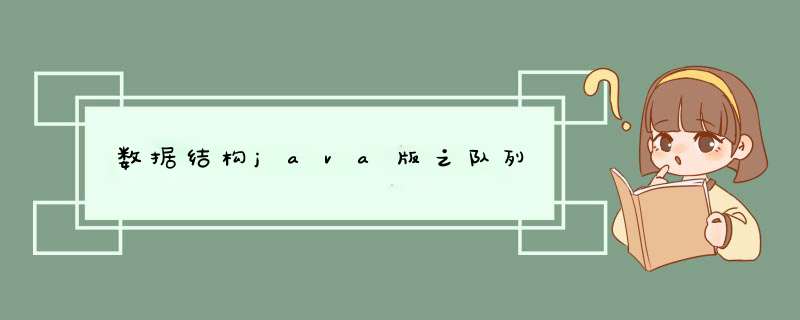
目录
一、简要介绍与队列相关知识
1.什么是队列
2.普通队列和双端队列
3.关于队列一些 *** 作的实现
4.循环队列
二、力扣上相关题目解析
1.设计循环队列
2.用队列实现栈
3.用栈实现队列
一、简要介绍与队列相关知识
队列的基本概念:
1.什么是队列只允许在一端进行插入数据 *** 作,在另一端进行删除数据 *** 作的特殊线性表,队列具有先进先出FIFO(First In First Out) 入队列:进行插入 *** 作的一端称为队尾(Tail/Rear) 出队列:进行删除 *** 作的一端称为队头(Head/Front)
2.普通队列和双端队列 3.关于队列一些 *** 作的实现①普通队列
Queue(一般多使用返回特殊值的处理,更加方便)
错误处理抛出异常返回特殊值 入队列add(e)offer(e) 出队列remove()poll() 队首元素element()peak() 简单代码示例:
import java.util.*; public class Test { public static void main(String[] args) { Queuequeue = new linkedList<>(); queue.offer(1); queue.offer(2); System.out.println("该队列队头元素为:"); System.out.println(queue.peek()); System.out.println("出队元素为"); System.out.println(queue.poll()); } } ②双端队列
Deque(一般多使用返回特殊值的处理,更加方便)
import java.util.*; public class Test { public static void main(String[] args) { Dequequeue = new linkedList<>(); queue.offerFirst(2); queue.offerLast(1); System.out.println("该队列队头元素为:"); System.out.println(queue.peek()); System.out.println("出队元素为"); System.out.println(queue.poll()); } } 用单链表实现队列:
代码:
class Node{ public int val; public Node next; public Node(int val){ this.val=val; } } //实质上是一个尾插法 public class MyQueue { public Node head; public Node last; public void offer(int val){ Node node=new Node(val); if(head==null){ head=node; last=node; } last.next=node; last=last.next; } //出队 public int poll(){ if(isEmpty()){ throw new RuntimeException("队列为空!"); }int oldVal=head.val; this.head=head.next; return oldVal; } public boolean isEmpty(){ return this.head==null; } //查看栈顶元素 public int peek( ){ if(isEmpty()) { throw new RuntimeException("队列为空!"); } return head.val; } }
4.循环队列
①循环队列的引入
二、力扣上相关题目解析 1.设计循环队列
622. 设计循环队列 - 力扣(LeetCode) (leetcode-cn.com)https://leetcode-cn.com/problems/design-circular-queue/解题思路:见一中循环队列及下图
代码:
class MyCircularQueue {
public int[]elem;
public int front;//队头下标
public int rear;//队尾下标
public MyCircularQueue(int k) {
this.elem=new int[k+1];
}
//入队 *** 作
public boolean enQueue(int value) {
if(isFull()) return false;
this.elem[rear]=value;
rear=(this.rear+1)%elem.length;
return true;
}
//出队 *** 作
public boolean deQueue() {
if(isEmpty()) return false;
//不用管原数,会被新入队的数直接替代
front=(this.front+1)% elem.length;
return true;
}
//得到队头元素
public int Front() {
if(isEmpty()) {
throw new RuntimeException("队列为空");//OJ上改为return -1;
}
return this.elem[front];
}
//得到队尾元素
public int Rear() {
if(isEmpty()) {
throw new RuntimeException("队列为空");//OJ上改为return -1;
}
int index=0;
if(rear==0){
index=elem.length-1;
}else{index=rear-1;}
return this.elem[index];
}
public boolean isEmpty() {
return front==rear;
}
public boolean isFull() {
//判断rear下一个是front就是满了
if((this.rear+1)% elem.length==front){
return true;
}
return false;
}
}
2.用队列实现栈
225. 用队列实现栈 - 力扣(LeetCode) (leetcode-cn.com)https://leetcode-cn.com/problems/implement-stack-using-queues/
解题思路:
①入栈的时候,入到不为空的队列,刚开始都为空指定入到一个队列
②出栈的时候,找到不为空的队列,出size-1个元素到另一个队列,剩下的这个元素就是出栈的元素
代码如下:
class MyStack { //创建两个队列 private Queue3.用栈实现队列qu1; private Queue qu2; public MyStack() { //初始化两个队列 qu1 = new linkedList<>(); qu2 = new linkedList<>(); } public void push(int x) { //哪个队列不为空,入到哪个队列里,均为空,随便入一个队列,此处入的是qu1 if (!qu1.isEmpty()) { qu1.offer(x); } else if (!qu2.isEmpty()) { qu2.offer(x); } else { qu1.offer(x); } } public int pop() { if (empty()) return -1; if (!qu1.isEmpty()) { int size = qu1.size(); for (int i = 0; i < size - 1; i++) { //需要拿一个中间值接收一下暂时出队的元素 //将出队元素放入另一个队中 int val = qu1.poll(); qu2.offer(val); } return qu1.poll(); } if (!qu2.isEmpty()) { int size = qu2.size(); for (int i = 0; i < size - 1; i++) { //需要拿一个中间值接收一下暂时出队的元素 //将出队元素放入另一个队中 int val = qu2.poll(); qu1.offer(val); } return qu2.poll(); } return -1; } //得到队头元素 public int top() { if (empty()) return -1; if (!qu1.isEmpty()) { //因为后续部分要用到val,所以必须拿出pop中局部变量的位置到前面 int val = -1; int size = qu1.size(); for (int i = 0; i < size; i++) { //需要拿一个中间值接收一下暂时出队的元素 //将出队元素放入另一个队中 val = qu1.poll(); qu2.offer(val); } return val; } if (!qu2.isEmpty()) { int val = -1; int size = qu2.size(); for (int i = 0; i < size; i++) { //需要拿一个中间值接收一下暂时出队的元素 //将出队元素放入另一个队中 val = qu2.poll(); qu1.offer(val); } return val; } return -1; } public boolean empty() { return qu1.isEmpty() && qu2.isEmpty(); } } 232. 用栈实现队列 - 力扣(LeetCode) (leetcode-cn.com)https://leetcode-cn.com/problems/implement-queue-using-stacks/解题思路:
代码如下:
class MyQueue {
public Stackstack1;
public Stackstack2;
public MyQueue() {
stack1=new Stack();
stack2=new Stack();
}
//出队第一个栈
public void push(int x) {
stack1.push(x);
}
public int pop() {
if(empty()) return -1;
if(stack2.isEmpty()){
while(!stack1.isEmpty()){
stack2.push(stack1.pop());
}
}
return stack2.pop();
}
public int peek() {
if(empty()) return -1;
if(stack2.isEmpty()){
while(!stack1.isEmpty()){
stack2.push(stack1.pop());
}
}
return stack2.peek();
}
public boolean empty() {
return stack1.isEmpty() && stack2.isEmpty();
}
}
欢迎分享,转载请注明来源:内存溢出

 微信扫一扫
微信扫一扫
 支付宝扫一扫
支付宝扫一扫
评论列表(0条)